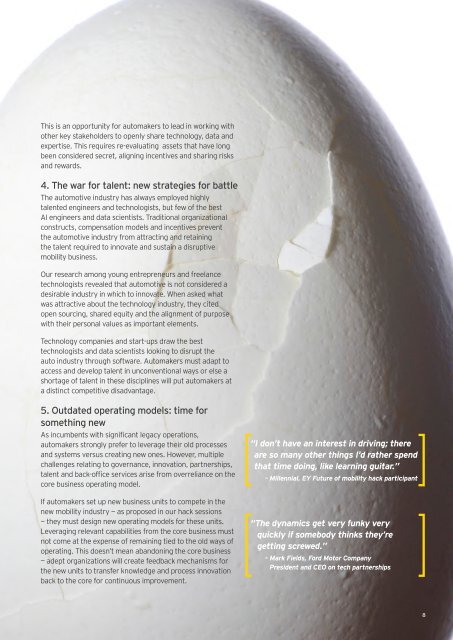Remodeling for mobility
ey-gac-remodeling-for-mobility
ey-gac-remodeling-for-mobility
You also want an ePaper? Increase the reach of your titles
YUMPU automatically turns print PDFs into web optimized ePapers that Google loves.
This is an opportunity <strong>for</strong> automakers to lead in working with<br />
other key stakeholders to openly share technology, data and<br />
expertise. This requires re-evaluating assets that have long<br />
been considered secret, aligning incentives and sharing risks<br />
and rewards.<br />
4. The war <strong>for</strong> talent: new strategies <strong>for</strong> battle<br />
The automotive industry has always employed highly<br />
talented engineers and technologists, but few of the best<br />
AI engineers and data scientists. Traditional organizational<br />
constructs, compensation models and incentives prevent<br />
the automotive industry from attracting and retaining<br />
the talent required to innovate and sustain a disruptive<br />
<strong>mobility</strong> business.<br />
Our research among young entrepreneurs and freelance<br />
technologists revealed that automotive is not considered a<br />
desirable industry in which to innovate. When asked what<br />
was attractive about the technology industry, they cited<br />
open sourcing, shared equity and the alignment of purpose<br />
with their personal values as important elements.<br />
Technology companies and start-ups draw the best<br />
technologists and data scientists looking to disrupt the<br />
auto industry through software. Automakers must adapt to<br />
access and develop talent in unconventional ways or else a<br />
shortage of talent in these disciplines will put automakers at<br />
a distinct competitive disadvantage.<br />
5. Outdated operating models: time <strong>for</strong><br />
something new<br />
As incumbents with significant legacy operations,<br />
automakers strongly prefer to leverage their old processes<br />
and systems versus creating new ones. However, multiple<br />
challenges relating to governance, innovation, partnerships,<br />
talent and back-office services arise from overreliance on the<br />
core business operating model.<br />
If automakers set up new business units to compete in the<br />
new <strong>mobility</strong> industry — as proposed in our hack sessions<br />
— they must design new operating models <strong>for</strong> these units.<br />
Leveraging relevant capabilities from the core business must<br />
not come at the expense of remaining tied to the old ways of<br />
operating. This doesn’t mean abandoning the core business<br />
— adept organizations will create feedback mechanisms <strong>for</strong><br />
the new units to transfer knowledge and process innovation<br />
back to the core <strong>for</strong> continuous improvement.<br />
“I don’t have an interest in driving; there<br />
are so many other things I’d rather spend<br />
that time doing, like learning guitar.”<br />
– Millennial, EY Future of <strong>mobility</strong> hack participant<br />
“The dynamics get very funky very<br />
quickly if somebody thinks they’re<br />
getting screwed.”<br />
– Mark Fields, Ford Motor Company<br />
President and CEO on tech partnerships<br />
8




